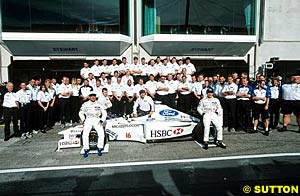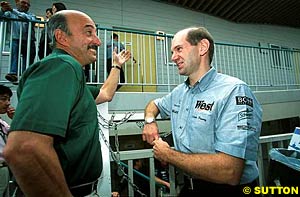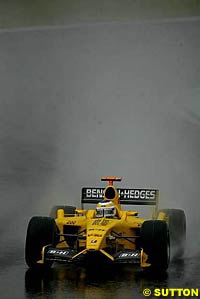
Atlas F1 Senior Writer
In May 2003, FIA President Max Mosley warned that Grand Prix racing is not the car industry's core business and that we as fans of the sport could count on only one thing: that manufacturers would come and go as they please, BMW, Mercedes Benz, Honda, Renault, Fiat, Alfa Romeo and Porsche, all having strutted their hour upon the stage and abandoned ship when it suited their corporate purposes. Atlas F1's Thomas O'Keefe traces the latest example of an auto giant pursuing its perceived self-interest, in the wake of Ford Motor Company's stunning announcement that it would discontinue its Jaguar Formula One operations and Cosworth engine works
It has been a pathetic and cynical performance by the Blue Oval, the way they have tarnished the once-proud leaping cat mascot, the way Ford has failed to provide adequate support to its corporate step-child. If this were Family Court, the way Jaguar has been treated by Ford would be an open and shut case of child abuse and neglect.
Don't get me wrong. I love Jaguar and no one wanted them to succeed more than me, as an American hooked on British sports cars at a young age. I have owned several early, rustbucket Jaguar XJ6's and E-Types, purchased with a glimmer of the dorsal-finned D-types at LeMans in my mind's eye. No matter how many times the Lucas electrics or the cooling systems have failed me in these cars, the hypochondriacs of the sport car set, I love them still.
When it was announced that an American, Bobby Rahal, was to become team principal of Jaguar on the eve of the inaugural 2000 US Grand Prix, I thought for sure that now we would see something from the team since Rahal was one of those rare individuals who had done it all and done it all successfully and without alienating anyone: a winner of the Indianapolis 500, a CART Champion when that meant something and, after retirement as driver, still a winner as a CART team owner. Along the way he had raced in Europe himself and in Formula One for the Wolf team, so surely the ingredients for Jaguar becoming a contender were now in place (See Man in the Catbird Seat). A side benefit to having an American as team principal could also mean that the Jaguar team would end up becoming a portal for an American driver to come up in the sport.
But it turned out that Rahal came into a bad situation not of his own making. Jackie Stewart had already hired ex-Ferrari driver Eddie Irvine as Jaguar's star driver and that was not destined to be a match made in heaven. Rahal also quickly perceived that the weak aerodynamics of the existing car would doom it to failure no matter who was driving it, so he went to his longest-standing friend in the F1 paddock – Adrian Newey of McLaren, whom Rahal had known from their days together in the Indycars, and the two of them decided the time was right for a Big Move. Newey for his part was disenchanted and feeling as if it were time to leave the womb of McLaren and looked forward to a new challenge with his old friend.
Both Rahal and Lauda were further victimized by Ford's insistence on navel-gazing, soul-searching bureaucrats who came in to assess why the team was a mess, but in an environment as dynamic and yet fragile as a Formula One team, no amount of Business School theorizing is ever going to point the way as to why some teams gel and some do not.
In other words, Ford has made every mistake in the book in its Jaguar Formula One Program, and will now convert the promising Tony Purnell from team principal to Receiver, presiding over a distress sale as to both Jaguar and Cosworth's assets. This is the saddest auction since Bernie Ecclestone bought two Connaught chassis from the Connaught Liquidation sale on September 17, 1957, that he used to race in the 1958 Grand Prix season. Indeed, I wonder if Bernie will be bidding again since he may need those Jaguar/Cosworth assets to make up a 20-car grid in 2005!
So that is how it turned out so poorly, but why did Ford pull the plug now and could it have all turned out differently?
Why now? It is the Economy, stupid, or more precisely the price of Ford's stock on the New York Stock Exchange (stock symbol "F"), which has been trading from as low as $10 to a high of $17 during the last year and consistently trails behind GM and DaimlerChrysler's stock, which tend to trade at $40 or more. I assure you it is no coincidence that while we in Formula One were feeling shockwaves from Jaguar's announcement on Friday, September 17, 2004, on that same day they were whooping it up at One American Road, Dearborn, Michigan, because management could see the favorable headlines from the New York Times: "Ford Raises Earnings Forecast and Unveils New Plan for Jaguar" and "Shares Rise on Ford's Optimistic Forecast on Earnings."
Along with improved earnings from Ford's "financial services" group, lancing a boil like the Jaguar Formula One operation along with closing the historic Browns Lane Jaguar factory where all my old Jaguars were built, was the kind of "costs savings" that 27 year-old analysts in the City and on Wall Street demand as their pound of flesh before giving a favorable forecast for a stock.
Ford's September 17th press release and Investor Presentation, as filed with the Securities and Exchange Commission ("SEC") was plainly written with the bean counters and stock analysts in mind:
Interestingly, by backing out of its numbers these "discontinued" F1 and Jaguar operations, Ford's earnings looked better:
In other words investors, let us forget about the F1 Jaguar fiasco and marvel at how wonderful our earnings would be otherwise.
The most entertaining part of Ford's SEC disclosure was the catalogue of "improvement actions" which Jaguar cars thought should turn things around, including for soccer moms "upcoming product actions [which] build on recent introduction of the X-Type Estate (wagon) in US Market."
You have to understand that Ford Motor Company has been through many significant chapters in its corporate history, but when it was announced on the frontpage of the Wall Street Journal on December 8, 2003, that Toyota was about to supplant Ford as the world's second largest carmaker, the handwriting was on the wall. Get back to our core business, selling cars, and get out of the prestige cars loser part of the business like Jaguar's Formula One team. Can Aston Martin and Jaguar itself be far behind as assets bound for the chopping block?
Ironically, at a time when Ford Cosworth, with the manufacturing capabilities at its command could have been the instrument that could save Formula One from its own excesses, the company has instead decided to abandon the arena entirely, again, chiefly, for "business" reasons relating to stock prices, forsaking the racing heritage that figured so heavily in the TV commercials Chairman of the Board, William Ford, narrated all last year in honor of Ford's 100th Anniversary. Henry Ford himself, who designed, built, and drove racing cars, would be spinning in his grave if he could see how his mighty company has fallen off the path he had chosen on October 10, 1901, when a car Henry Ford built nicknamed Sweepstakes beat American Champion Alexander Winton, Ford's first race win.
Indeed, I thought Ford was back on the path the way things were shaping up, with the FIA trying to reduce costs and induce engine manufacturers to imitate Ford Cosworth by making engines available more broadly to those lower down on the Formula One food chain. I figured Tony Purnell and Ford were going to seize the opportunity to become the anti-Ferrari, the engine supplier of first resort beyond the grandees of Ferrari, Honda, Mercedes and BMW, as it had been back in the good old days of 1989, when as many as 15 of the 26 cars on the grid had Ford engines.
I had even hoped along the way that Ford will use the basic Ford Cosworth powerplant and re-badge it to assist in the marketing of its other racing breed, Aston Martin (See Shaken But Not Stirred), which had briefly been in Formula One but had retired prematurely (as Jaguar is being prematurely cast aside) in favor of Aston Martin's focus on Le Mans. And yet there is a warren of old-fashioned engine rooms at the Newport Pagnell Aston Martin plant where the engines produced are works of art and the men who produce them artists and craftsman. Does William Ford even know that these resources and craftsman exist that could, with proper attention, rival the engine works at Maranello?
Is it so inconceivable that Ford Cosworth – which had at one point this season the capability of producing three different iterations of the Cosworth engine for Minardi, Jordan and Jaguar – under the resourceful and inventive leadership of Tony Purnell, could have rationalized the engine–making infrastructure it has under its umbrella to end up powering a Ford Blue Oval factory team, and an Aston Martin team, along with the privateers like Jordan and Minardi and make a go of it financially in that way, while also improving the sport and expanding the grid?
It had been done before in the Formula Cosworth era in the 1980's and indeed the ChampCar series is an all-Ford Cosworth affair, though that arrangement too is bound to change with the divestitures announced by Ford and Cosworth on September 17, a day that will live in automobile infamy.
Ford has been dumb before. Remember they came very close to buying Ferrari from Enzo Ferrari for $18 million in the dark days of 1963 at Maranello, when the Old Man was under lots of financial pressure. He needed to be assured by the Ford executives that the Racing Division would remain under his control – which is all he ever cared about - but the Ford due diligence team could not stomach that or see a way to negotiate around it and the bean counters left Maranello in a huff. The Commendatore ultimately succumbed to being acquired by Fiat in 1969 and the rest is history.
There is only one certainty in all of this. As Max Mosley's dictum states, "Company chiefs change and what today is fixed policy can tomorrow be seen as a mistake of the previous administration." The Blue Oval will be back, once the stock analysts are happy, once Ford's Premier Automotive Group in all of its manifestations is fully cashiered, and once the company is stripped of the elan, prestige and European cachet that the acquisitions of Jaguar, Aston Martin and Land Rover were intended to add to the mix.
And oh, by the way, Mr. Ford, Chairman of the Board: much as I love Jaguars, I will not be ordering one of those Jaguar X-Type Estate Wagons being introduced to boost Jaguar sales with soccer moms, knowing that the price for all that Connelly leather and Wilton carpet is the decline of Formula One as a sacrifice on the alter of the stock market. The Blue Oval makes me blue.
I remember walking into the paddock at Silverstone for the 2000 British Grand Prix, the particularly soggy one that so alienated Bernie Ecclestone, where the conditions were so bad that even a Land Rover got stuck in trying to retrieve David Coulthard's McLaren. What first struck my eye filled me with pride. There amidst the glamorous motorhomes, a huge, gleaming, leaping Jaguar made of chrome was positioned on top of the Jaguar motorhome, the same hood ornament that had made Jaguar cars so famous, but on steroids and looming over the paddock.
 The Jaguar Formula One team had barely seven races under its belt since being formed out of the ashes of Stewart Grand Prix. Johnny Herbert in a Stewart-Ford had brought home a thrilling and unlikely victory at a wet/dry Nurburgring race less than six months earlier in November 1999 so it seemed that the team had turned the corner: who would have thought at that juncture that the resources of what was until recently the worlds second largest auto manufacturer – Ford Motor Company – could not match, let alone outdistance, the solitary victory of the Stewart team from which this cat had sprung.
The Jaguar Formula One team had barely seven races under its belt since being formed out of the ashes of Stewart Grand Prix. Johnny Herbert in a Stewart-Ford had brought home a thrilling and unlikely victory at a wet/dry Nurburgring race less than six months earlier in November 1999 so it seemed that the team had turned the corner: who would have thought at that juncture that the resources of what was until recently the worlds second largest auto manufacturer – Ford Motor Company – could not match, let alone outdistance, the solitary victory of the Stewart team from which this cat had sprung.
 But neither Rahal nor Newey has the conniving constitution of a corporate raider type and both would soon be crushed by McLaren's lawyers, who clearly got the message from Ron Dennis to pull out all the stops to keep Newey on board whether he wanted to stay or not. No one hates losing like Ron Dennis and, in the end, some form of secret financial settlement was entered into and Newey was sent back to his box of pencils and drafting board at Woking. Rahal tried to re-cast the team in other ways, undermined throughout his efforts by the unhelpful insertion by Ford higher-ups of Niki Lauda, ex-Ferrari, ex-McLaren, RTL TV commentator who Ford for some reason thought was tailor-made for bringing order out of chaos – the "Austrian" way vs. the "American" way is the way Lauda's makeover was characterized. Lauda gradually froze out Rahal but proved to be better at corporate infighting than running a Formula One team since Lauda failed too.
But neither Rahal nor Newey has the conniving constitution of a corporate raider type and both would soon be crushed by McLaren's lawyers, who clearly got the message from Ron Dennis to pull out all the stops to keep Newey on board whether he wanted to stay or not. No one hates losing like Ron Dennis and, in the end, some form of secret financial settlement was entered into and Newey was sent back to his box of pencils and drafting board at Woking. Rahal tried to re-cast the team in other ways, undermined throughout his efforts by the unhelpful insertion by Ford higher-ups of Niki Lauda, ex-Ferrari, ex-McLaren, RTL TV commentator who Ford for some reason thought was tailor-made for bringing order out of chaos – the "Austrian" way vs. the "American" way is the way Lauda's makeover was characterized. Lauda gradually froze out Rahal but proved to be better at corporate infighting than running a Formula One team since Lauda failed too.
"On September 17, 2004, Ford Motor Company decided to exit Formula One racing and to sell its Formula One racing operations within the next year, as market conditions warrant. In accordance with generally accepted accounting principles, those racing operations are being classified as discontinued operations and we will incur an impairment charge estimated at about $275 million pre-tax. Ford Motor Company [also] committed to plans to close the final assembly operations at Browns Lane in Coventry, England and reduce salaried staffing levels at its Jaguar operations. Browns Lane is currently used for final assembly of Jaguar XJ and Jaguar XK model cars."
"The exhibits [filed with the SEC] discuss our updated earnings guidance on a per share basis that excludes results from discontinued operations and excludes special items. We believe the earnings per share measure excluding results from discontinued operations and excluding special items is useful to investors because it excludes elements that we do not consider indicative of earnings from our on-going operating activities and, accordingly, provides investors with a more relevant measure of the results of our operations."
 How could it have been different? This is the saddest part of the story. Ford, thorough its subsidiary Cosworth, was Formula One for years, the basic Cosworth DFV and its variations on the theme providing the grunt for the majority of the grid for some of the most exciting eras of Formula One: 176 victories with Ford engines (second only to Ferraris engines at 180 and counting), driven by the luminaries of the sport from Jim Clark to Michael Schumacher, the last driver to win a race powered by Ford. (Giancarlo Fisichella's 2003 Brazilian Grand Prix-winning Jordan was powered by the Ford Cosworth RSI.)
How could it have been different? This is the saddest part of the story. Ford, thorough its subsidiary Cosworth, was Formula One for years, the basic Cosworth DFV and its variations on the theme providing the grunt for the majority of the grid for some of the most exciting eras of Formula One: 176 victories with Ford engines (second only to Ferraris engines at 180 and counting), driven by the luminaries of the sport from Jim Clark to Michael Schumacher, the last driver to win a race powered by Ford. (Giancarlo Fisichella's 2003 Brazilian Grand Prix-winning Jordan was powered by the Ford Cosworth RSI.)
|
Contact the Author Contact the Editor |
Please Contact Us for permission to republish this or any other material from Atlas F1.
|
Volume 10, Issue 38
Atlas F1 Special
Jaguar: All Out of Lives
Last to Know, First to Go
The Tarnished Mascot
Articles
The Gold Rush
Revved Up: Q&A with Shoichi Tanaka
Every Other Sunday
2004 Chinese GP Preview
2004 Chinese GP Preview
Chinese GP Facts & Stats
Columns
The F1 Trivia Quiz
Bookworm Critique
On the Road
Elsewhere in Racing
The Weekly Grapevine
> Homepage |